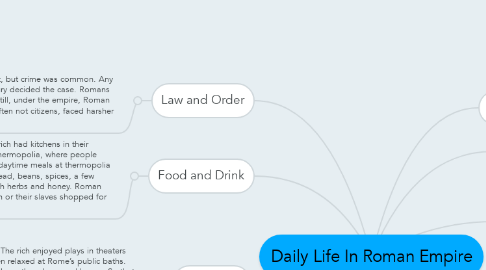Daily Life In Roman Empire
by lily vargo

1. Daily Life In Rome
1.1. almost one million people live in the city of Rome. Rome was fulled with large beautiful displays and architecture such as beautiful temples, stately buildings, and flowering gardens. In ancient Rome there was thousands of slaves roaming the streets and working for their masters. only a small population of Rome was rich most of the other towns were less wealthy.
2. Law and Order
2.1. Romans believed in the rule of law. Laws were strict, but crime was common. Any Roman could accuse someone else of a crime. A jury decided the case. Romans believed that one law should apply to all citizens. Still, under the empire, Roman law was not applied equally. The poor, who were often not citizens, faced harsher punishments than the rich; sometimes even torture.
3. Food and Drink
3.1. What Romans cooked and ate depended on whether they were rich or poor. Only the rich had kitchens in their homes. The poor cooked on small grills and depended on “fast-food” places called thermopolia, where people could buy hot and cold foods that were ready to eat. Even the rich often bought their daytime meals at thermopolia because the service was fast and convenient. The main foods in ancient Rome were bread, beans, spices, a few vegetables, cheeses, and meats. Favorite drinks included plain water and hot water with herbs and honey. Roman markets offered many choices to those who could afford them. Wealthy Roman women or their slaves shopped for the perfect foods for fancy dinner parties.
4. Recreation
4.1. There was lot of recreation in Rome because the slaves did all the work. The rich enjoyed plays in theaters and musical performances in each others homes. Both rich and poor often relaxed at Rome’s public baths. Roman emperors made sure to give the poor food and entertainment to keep them busy and happy. So that they will continue recreating. For example Romans watched gladiators fight in the Colosseum. Both men and women were gladiators. Usually, they were slaves or prisoners of war, although some won or bought their freedom in time. Many thousands of gladiators died bloody and painful deaths for the entertainment of the spectators.
5. Country Life
5.1. Rome was one of many cities scattered throughout the Roman Empire. 90 percent of the empires people lived in the country. lots of wealthy Romans often owned country estates with large homes. A villa was a place for Romans to invest their money in raising crops and livestock. The empire’s farms provided much of the food for Rome and other cities. Many people in the countryside were not slaves. the ones that were lived in huts and worked their own small farms, trying to earn enough to survive.
6. Religion
6.1. Religion was part of daily life. Romans made offerings to the gods. Festivals and holy days were held throughout the year. Each home had an altar for household gods and spirits. The Romans also honored their emperors as gods.
7. Family Life
7.1. Each family was ruled by the paterfamilias. At nine days old, a baby was given a bulla, which he or she wore throughout childhood. Between 14 and 18, a boy became a man. Girls became adults when they were married, between 12 and 18.
8. Housing
8.1. housing was very different in Rome for the rich and for the poor. The spacious, airy homes of the rich stood side by side with the small, dark apartments that housed the poor.Wealthy Romans lived in grand houses, built of stone and marble. Thick walls shut out the noise and dirt of the city.Inside the front door was a hall called an atrium where the family received guests. An indoor pool helped to keep the atrium cool. An opening in the roof let in plenty of light.
9. Education
9.1. Many poor children in Rome learned trades, instead of going to school. Wealthier boys and girls were tutored by their fathers or by slaves until they were about 6. Then boys went to school. Roman boys learned Latin, Greek, math, science, literature, music, and public speaking. Upper-class boys stayed in school until age 12 or 13. The rich enjoyed plays and musical performances. Both rich and poor often relaxed at Rome’s public baths. Besides celebrating many festivals, rich and poor alike enjoyed viewing gladiator contests and chariot races.
10. By: Lily Vargo


